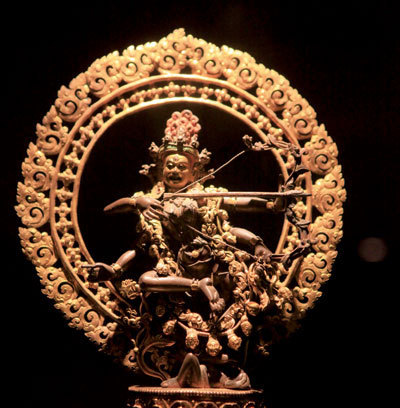|

Debra Li
debra_lidan@163.com
IT’S not necessary to become a Buddhist to experience the religion — at least not this week.
Until Saturday, 88 Buddhist statues of high artistic value dating back to the Eastern Han Dynasty (25-220) are on display at Artron Art Gallery. The exhibition allows locals a rare chance to appreciate the ancient relics face-to-face and get vivid lessons on Buddhist culture and art history.
“Buddhism has brought unfathomable new dimensions to Chinese culture,” Artron spokesman Li Zhiqi said. “It has led us to ask philosophical questions about life and death, values and meanings. Buddhism has largely influenced literary and artistic styles as well.”
With detailed explanations beside each exhibited item, the show can help even laypersons understand a little about Buddhism and related sculptures, on a tour back into the past.
Of the 88 exhibited statues, 74 are made of bronze alloys and 14 are made of stone. Spanning more than 1,000 years of history, the statues, from the collection of Beijing-based Poly Group, are estimated to be worth a total of 1.5 billion yuan (US$ 384 million). More than half of them are second-class national cultural relics and a third are first-class relics.
The 14 stone pieces are among the nearly 400 Buddhist statues excavated at the ancient Longxing Temple site in Qingzhou, Shandong Province in 1996 and represent the highest achievement of stone sculptures from the Northern Dynasties (386-581). One piece from the Northern Wei Dynasty (386-534) is especially precious. With a complete shield carved with delicate patterns behind the Buddha’s back, and two Bodhisattvas at either side, the statue is well preserved, with gold foil still adhering to surface parts. The Buddha has facial features of ethnic minorities, with narrow eyes slanting into sideburns and a peaceful smile lingering on his lips.
Another granite statue created in the Tang Dynasty (618-907) was excavated from the site of the family temple of an emperor. Made by imperial craftsmen, the statue presumably was used in sacrificial rituals. The Bodhisattva, plump in body and round in face, reflects the typical aesthetic taste of the time.
The most precious of the bronze alloy statues is a gilded Bodhisattva cast during the Ming Dynasty (1368-1644) by craftsmen of the imperial court. The sitting statue is 75 centimeters tall and features a lotus flower on both shoulders. The wreath on his head and decorative beads on his chest are elaborate, and his facial expression is vivid.
“This statue is rare, because traits of both Tibetan and Mandarin influences are represented,” a docent said.
“The statues reflect the art styles of various times,” the docent explained. “Those from the Northern Dynasties feature simple lines, those from the Tang Dynasty are plump, those from the Song Dynasty reflect the joy of mundane life and those from the Ming Dynasty are elaborate and highly skillful.”
Many of the bronze alloy statues are from Tibet or Nepal. Some feature Drolmas, or female Bodhisattvas.
To better present the statues, calligraphies and paintings decorate the halls and provide background information on Buddhist art.
The show is a featured event during the 9th China (Shenzhen) International Cultural Industries Fair. Admission is free.
Time: Until May 25
Venue: Artron Art Gallery, 5 Meidong Road 2, Futian District
Metro: Longhua Line, Shangmeilin Station (上梅林站), Exit A
Tel: 8251-2119
Website: www.artron.net
|

